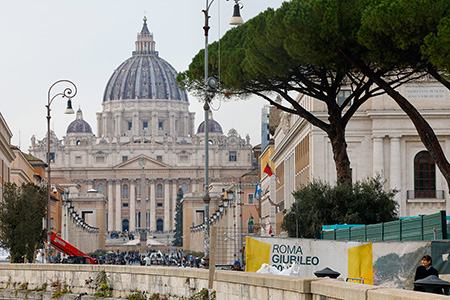
NATION
ATLANTA (OSV News) – Notre Dame’s quest for a 12th national title ended in heartbreak with a 34-23 loss to Ohio State in the College Football Playoff national championship Jan. 20 at Mercedes-Benz Stadium in Atlanta. Head coach Marcus Freeman and captains Riley Leonard and Jack Kiser faced the media with heavy hearts but praised their team’s perseverance and faith. “It’s a tough moment,” Freeman said. But of the team he said, “I’m just proud of them and proud of what they’ve done.” Leonard, who transferred from Duke for his senior year, thanked Jesus Christ and highlighted Scripture that inspired him, including Matthew 23:12 and Proverbs 27:17. He acknowledged his disappointment but credited Notre Dame’s coaches and players for shaping his journey. Kiser, reflecting on six seasons with the Irish, emphasized the program’s culture. “It’s the people that make this place different,” he said.
KEY WEST, Fla. (OSV News) – A lot has changed in the lower Florida Keys since the 1980s, when declining enrollment led to the closure of the Catholic high school in the oldest and southernmost parish of the Archdiocese of Miami. But a surge in local economic development, tourism jobs and a renewed demand for private and Catholic education in Monroe County culminated Dec. 13 in the dedication Mass and grand opening of a refurbished Basilica High School building and facility at the Basilica of St. Mary Star of the Sea Parish and School in Key West. Miami Archbishop Thomas G. Wenski presided at the dedication Mass and grand opening. The new facility will allow for full enrollment in 2025 of all four grades under the leadership of principal and president Robert Wright and will serve as an answered prayer for local parents who had few options for private education in Monroe County. The nearest Catholic high school was located in Miami-Dade County, meaning some families left the Key West area in search of a Catholic education for their children, while others settled for public education.
VATICAN
ROME (CNS) – Before the millions of pilgrims expected to come to Rome during the Holy Year 2025 cross through the Holy Door of St. Peter’s Basilica, they will be met by smiling faces and lime green jackets. Jubilee volunteers of all ages and nationalities have become a mainstay along the boulevard leading up to St. Peter’s Square since the start of the Holy Year. Wearing uniforms emblazoned with “volontario” across their backs and the Jubilee and Vatican logos on their chests, the volunteers line the pilgrims’ path, offering guidance and companionship on their spiritual journey. They escort pilgrims along the final leg of their pilgrimage to the Holy Door, checking passes, providing directions and accompanying groups in prayer. For Craig and Laura Shlattmann – a married couple of Jubilee volunteers from Tacoma, Washington – participating in the current Holy Year has been 25 years in the making. Craig was stationed in Italy for military service, and the couple lived in Rome during the Holy Year 2000. Back then they “vowed, God willing, to come back for the next ordinary Jubilee year in 2025,” Laura told Catholic News Service. After Craig’s recent retirement, the couple decided to fulfill that promise. “We returned not just for ourselves … but also to help our family, friends and everyone who comes to Rome,” Craig said Jan. 23. “It’s been a real blessing.”
VATICAN CITY (CNS) – Taking up the spirit of the recently inaugurated Holy Year 2025, the Cuban government has announced the release of 553 people currently serving prison sentences. Cuba said it would gradually release the prisoners “in the spirit of the Ordinary Jubilee of the year 2025 declared by His Holiness” following a “thorough analysis” of the legal and humanitarian avenues to enact their release, Cuba’s Ministry of Foreign Affairs announced in a statement Jan. 14. The statement did not specify who would be among the 553 prisoners designated to be released. That same day, the White House announced that it will no longer designate Cuba as a state sponsor of terrorism and that it would eliminate some restrictions on Cuba. The White House said the actions were steps “to support the Cuban people as part of an understanding with the Catholic Church under the leadership of Pope Francis and improve the livelihoods of Cubans.” Following the announcement, Cardinal Seán P. O’Malley, retired archbishop of Boston, said that for the last several years he had carried messages from Pope Francis to the presidents of the United States and Cuba “seeking the release of prisoners in Cuba and improved relationships between the two countries for the good of the Cuban people.”
WORLD
JERUSALEM (OSV News) – Catholic leaders in the Holy Land are urging Christians to return on pilgrimage to the region now that a ceasefire has been established between Israel and Hamas. In a video, the Latin patriarch, Cardinal Pierbattista Pizzaballa, and the custos of the Holy Land, Franciscan Father Francesco Patton, walk through Jerusalem, talking to pilgrims and shopkeepers who have endured streets emptied of tourists since the Oct. 7, 2023, Hamas attack on Israel and the subsequent 15-month war. The area is safe, the Holy Land church leaders stressed. Father Patton emphasized the spiritual importance of visiting holy sites. Cardinal Pizzaballa called the ceasefire a “turning point” for the Holy Land, thanking churches worldwide for their support during the challenging year. Father Gabriel Romanelli from Gaza City’s Holy Family Parish expressed hope for lasting peace, despite the ongoing challenges.
PARIS (OSV News) – After Notre Dame Cathedral’s splendid reopening, the attention of Paris Catholics turned to the nearby Church of Notre Dame de Boulogne Jan. 12 as it was solemnly elevated to the rank of minor basilica, following a decree from Pope Francis, signed June 29. The Jan. 12 elevation ceremony was presided over by Bishop Matthieu Rougé of Nanterre, along with the apostolic nuncio to France, Archbishop Celestino Migliore. Located in the town of Boulogne-Billancourt, Notre Dame de Boulogne has deep historical roots, dating back to 1319 when French King Philip IV founded it to replicate a pilgrimage site in northern France. Over 700 years later, the church is still a center of faith in the region. Bishop Rougé said reviving its spiritual mission is important, especially because it is located in a major economic hub of the Paris metro area. The church’s rich architecture blends Gothic and 19th-century styles, and the church itself is a popular place of devotion for locals and visitors alike. Bishop Rougé hopes its new basilica title will invigorate evangelization efforts and provide spiritual hope in an increasingly secular society. Notre Dame de Boulogne is now the 176th basilica in France.

